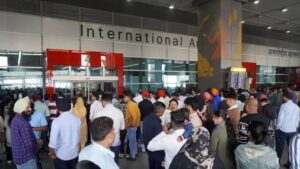Digital News Guru New Delhi Desk:
Technical Glitch at IGI Airport (Delhi) Grounds Hundreds of Flights
A significant technical disruption at India’s busiest airport, Indira Gandhi International Airport (IGI) in Delhi, has led to widespread flight delays and operational chaos across multiple airlines. Late on the evening of Thursday 6 November 2025, the airport’s air-traffic control (ATC) messaging system — specifically the Automatic Message Switching System (AMSS) which helps generate flight-plans and coordinate aircraft movements — suffered a fault.
As a result, controllers were forced to switch to manual processing of flight plans, dramatically slowing take-off operations.
The disruption affected both departures and arrivals, domestic and international flights alike.

Scale of the Impact
- According to various sources, more than 800 flights were delayed as a direct consequence of the system failure at IGI.
- The average departure delay was reported at around 55 minutes in early assessments.
- An advisory from the airport operator confirmed at least 100 flights had been delayed, with some reports citing nearly 700–800.
- Some airlines reported cancellations (at least 20), and ripple-effects were felt at other airports in northern India.
Why It Mattered
This disruption is particularly significant for several reasons:
- IGI Airport handles over 1,500 flight movements daily, making it one of the busiest hubs in India and globally.
- When such a key system fails, the cascading effect hurts not just one airline or one route, but the broader network — including connecting flights, downstream schedules and resources (crews, aircraft, gates).
- The fact that a “back-office” system like AMSS could impair operations to this extent shows how critical automation is in modern ATC, and how vulnerable disruption can be.
What Went Wrong
The root cause appears to be the failure of the AMSS. According to reports:
- The AMSS was unable to automatically generate and distribute flight-plans and associated data, forcing controllers to revert to manual processes.
- Manual flight-plan generation significantly slows down the pipeline of departures, especially at an airport with high throughput.

- The airport’s operator and the Airports Authority of India (AAI) confirmed that technical teams were working to restore the system and that it was “up and functional” by Friday afternoon, although residual delays remained due to backlog.
While initial investigations are ongoing, speculation includes possible system overload or even malware (though no official confirmation of the latter has been made).
Airlines & Passenger Response
- Major domestic carriers such as IndiGo, SpiceJet and Air India issued advisories to passengers to check flight status and anticipate delays.
- Many passengers encountered long wait times at boarding gates and check-in counters, as flights were held back and airport congestion increased.
- The airport advised travellers to arrive earlier than usual and to keep in close touch with their airlines for updated departure times.
Steps Taken & Current Status
- AAI and the airport operator issued official updates saying the AMSS system is restored and working, though automated workflows are still catching up and delays may persist temporarily.
- Airlines are gradually normalising operations, but due to backlog (grounded aircraft, delayed departures, crew availability) full schedule normalcy may take some time.
- Other airports in the region (e.g., Mumbai) reported knock-on effects because of sequences of flights and crew movement disruptions.
Looking Ahead: Challenges & Lessons
- Resilience & Redundancy: This event underlines the importance of having robust backups and fail-safe mechanisms for mission-critical systems in ATC infrastructure.
- Network Effects: Even a “single” system failure at a major hub can have a country-wide ripple across aviation operations.
- Operational Agility: Manual processes can sustain operations temporarily, but are not sufficient at the scale of IGI’s traffic; the slower pace of manual processing causes significant gridlock.
- Passenger Communication: Ensuring timely, accurate updates to passengers is essential to managing disruption – this event will likely prompt review of communication protocols.
- Investigation & Prevention: Identifying root cause (whether technical fault, overload, cybersecurity breach) is key to preventing recurrence.

What Passengers Should Know
- If flying out of IGI Airport in the near future, check your flight status frequently, arrive early and anticipate possible delays.
- Connecting flights might also be affected due to the upstream disruption.
- Maintain awareness of your rights: delay or cancellation compensation may be applicable depending on airline policy and regulatory context.
- Stay updated via official airline apps/websites and the airport’s social media updates until full normalcy is restored.
Conclusion
The technical glitch at IGI Airport’s ATC messaging system has exposed how reliant modern aviation operations are on digital infrastructure. With upwards of 800 flights delayed and disruption across domestic and international schedules, the event highlights both the strengths and vulnerabilities of today’s high-volume hub operations. While the system is now reported to be functional, the backlog and ripple effects may linger. For passengers, the message is clear: stay informed, prepare for delays, and keep flexible in the near term as the airport and airlines work through the disruption.
You May Also Read: 150 Years of ‘Vande Mataram’: Gujarat’s Grand Commemoration on November 7 2025








